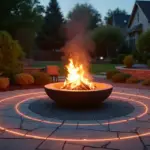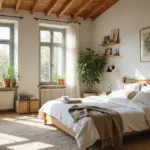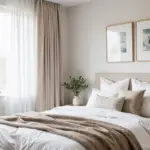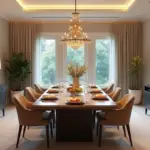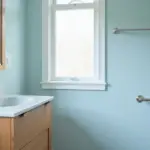Picture this: you’re standing in your dining room, surrounded by the crisp scent of fresh pine forests and the warm glow of the midnight sun. Now, imagine infusing that same sense of natural wonder into your dining space through the transformative power of paint. As an Alaskan architect with a passion for sustainable design, I’ve seen firsthand how a well-executed paint job can turn an ordinary room into an extraordinary gathering place. Whether you’re looking to create a cozy nook for intimate family dinners or a vibrant space for hosting festive potlucks, this dining room paint guide will help you navigate the process like a true Alaskan trailblazer. So grab your brushes, channel your inner aurora borealis, and let’s embark on a painting adventure that would make even the most seasoned Iditarod musher proud!
Key Takeaways
Before we dive into the nitty-gritty, let’s lay out our trail markers – the key points that will guide us through this painting expedition:
- Preparation is key: Just like gearing up for an Arctic expedition, proper wall prep ensures a smooth journey.
- Quality matters: Invest in high-grade paint – it’s the difference between a fleeting Northern Lights display and one that lasts all night.
- Tool up wisely: Gather your equipment like a seasoned outdoorsman – be prepared for every painting scenario.
- Prime for success: A good primer is like a base camp – it sets you up for the climb ahead.
- Master the edges: Cutting-in is your compass – it keeps you on track and your lines sharp.
- Roll with purpose: The W pattern is your snowshoe – it helps you cover ground evenly and efficiently.
- Layer for depth: Multiple coats are like layers of warm clothing – they provide depth and protection.
- Clean up conscientiously: Proper tool care and paint disposal are as important as Leave No Trace principles in the wilderness.

Now, let’s break trail and explore each of these points in detail!
Prepare Your Walls
Just as we Alaskans prepare our homes for the harsh winter months, your dining room walls need proper preparation before they can withstand the test of time and taste. Let’s start our painting journey with a solid foundation.
Clean Surfaces
Imagine you’re about to build an igloo. You wouldn’t start with dirty snow, would you? The same principle applies here. Begin by wiping down your walls with a damp cloth, paying special attention to those stubborn areas that might harbor grease or grime. For tougher spots, a mild detergent solution can work wonders – think of it as the gentle cleansing power of a pristine mountain stream.
Repair Imperfections
Now, channel your inner wilderness first-aid skills. Just as you’d patch up a tear in your tent, it’s time to address any holes or cracks in your walls. Use spackle or filler to smooth out these imperfections, then sand them down once dry. Run your hand over the surface – it should feel as smooth as a well-worn river stone.

Tape Off Areas
Here’s where precision comes into play. Much like mapping out a safe route through glacier crevasses, use painter’s tape to protect trim and edges. Press it down firmly – you want a seal as tight as a properly pitched Arctic tent. This step ensures your color boundaries are as crisp as the line between tundra and taiga.
Protect Furniture
Before the paint starts flowing, protect your furnishings like you would gear from an impending snowstorm. If possible, move furniture out of the room. For pieces that must stay, cover them with drop cloths or plastic sheets. Secure these covers tightly – you don’t want any surprise splatters, just as you wouldn’t want unexpected drafts in your winter cabin.
Select Quality Paint
Choosing the right paint is like selecting the perfect gear for an Alaskan adventure – it can make or break your experience. Let’s explore the terrain of paint selection with the discerning eye of a seasoned explorer.

Choose Paint Finish
The finish of your paint is akin to choosing the right outer layer for your expedition gear. Each has its purpose:
- Matte finishes are like the subtle beauty of fresh snow – they hide imperfections but aren’t as durable.
- Satin or eggshell finishes offer a slight sheen, like sunlight glinting off a glacier – they’re more durable and great for family dining areas.
- Semi-gloss or gloss finishes are the hardy outer shell of your expedition jacket – highly durable and easy to clean, perfect for high-traffic areas.
Consider how artificial light and paint color interact in your space – it can dramatically affect the ambiance, much like the ever-changing Arctic light transforms the landscape.
Pick Color Palette
Selecting colors is an art form, much like capturing the perfect photograph of the Northern Lights. Consider the existing decor and natural light in your dining room. Are you aiming for a warm, cozy atmosphere like a cabin in the woods, or a cool, refreshing vibe reminiscent of a glacial lake? Don’t forget to explore the best dining room colors for entertaining – the right hue can set the perfect mood for your gatherings.

Fun fact: In Inuit culture, different words describe various types of snow. Similarly, subtle variations in paint color can dramatically change the feel of a room. Test small patches on your wall to see how they look in different lighting conditions throughout the day.
Consider Eco-Friendly Options
As an advocate for sustainable living, I always recommend eco-friendly paint options. These are like the Leave No Trace principles of the painting world – they minimize harm to the environment and your indoor air quality. Look for low-VOC or zero-VOC paints, which release fewer harmful chemicals into the air. Some paints are even made with natural ingredients, like milk protein or plant-based materials. Choosing these options is like opting for responsibly sourced, local materials in construction – it’s better for you and the planet.
Gather Essential Tools
Assembling your painting toolkit is like packing for an Alaskan expedition – every item serves a crucial purpose. Let’s make sure you’re equipped for success!
Brushes and Rollers
Your brushes and rollers are the workhorses of your painting adventure, much like a trusty pair of hiking boots on a long trek. For precision work around edges and corners, arm yourself with high-quality brushes. They’re your ice axe for detailed maneuvers. Rollers, on the other hand, are your snowshoes for covering large, flat surfaces efficiently. Choose the right nap (thickness) for your paint and wall texture – a smooth wall calls for a short nap, while textured surfaces need a thicker one.

Paint Trays and Liners
Think of paint trays as your portable base camps. They hold your paint supply and allow for even distribution onto your roller. Liners are the unsung heroes here – they make cleanup a breeze, like those handy biodegradable bags we use to pack out waste from a campsite. Pro tip: don’t overfill your tray. It’s like packing too much for a day hike – you’ll end up with more than you can handle.
Drop Cloths and Tape
Drop cloths are your first line of defense against paint spills, like a good groundsheet protecting your tent floor. Opt for heavy-duty cloths that won’t slip underfoot – safety first, just as on any wilderness expedition. Painter’s tape is your boundary marker, creating clean lines and protecting areas you don’t want painted. Apply it with the precision of a cartographer mapping uncharted territory.
Ladders and Step Stools
For reaching those high spots, a sturdy ladder or step stool is essential. It’s your way of safely scaling the heights, much like the equipment we use for ice climbing. Always maintain three points of contact when using these – it’s a safety rule that applies whether you’re on a mountain face or in your dining room.

Apply Primer First
Priming your walls is like laying down a base camp before attempting a summit push. It sets the stage for everything that follows, ensuring your paint job is as enduring as the ancient glaciers of Alaska.
Benefits of Primer
Primer is the unsung hero of the painting world, much like the sturdy foundation of an Arctic research station. It creates a uniform surface for paint adhesion, ensuring your color coat sticks around longer than a stubborn patch of permafrost. Primer also helps to cover dark colors and stains, acting like a fresh blanket of snow, giving you a clean slate to work with. By using primer, you’re likely to need fewer coats of paint, saving time and resources – efficiency that any Arctic explorer would appreciate.
Types of Primer
Just as we have different types of snow gear for various conditions, there are different primers for different surfaces:
- Oil-based primers are like the heavy-duty winter gear of the primer world. They’re great for wood and stained surfaces, sealing in tannins and preventing bleed-through.
- Water-based primers are your lightweight, quick-drying option – perfect for drywall and plaster. They’re easy to clean up, like those handy wet wipes on a camping trip.
- Shellac-based primers are the problem-solvers, like a multi-tool in your pack. They’re excellent for blocking tough stains and odors, ensuring a clean start.

How to Apply Primer
Applying primer is a bit like setting up camp – it requires attention to detail for the best results. Start by stirring the primer thoroughly, mixing any settled materials like you’d mix a hearty camp stew. Apply it in thin, even coats using a brush or roller, much as you’d lay out a tarp – no lumps or bumps. Allow each coat to dry completely before moving on, just as you’d let your gear dry out between adventures. Check the label for specific drying times – it’s like checking the weather forecast before a hike.
Master Cutting-In Technique
Cutting-in is the fine art of painting clean edges and corners – it’s like tracing the perfect line on a topographic map. Master this technique, and you’ll achieve results as crisp as the Alaskan air on a winter morning.
Use Angled Brush
An angled brush is your precision instrument, like the delicate tools used in ice sculpting. Its slanted bristles allow for greater control and accuracy, especially in tight spots. When choosing your brush, look for one with synthetic bristles – they’re like high-tech gear, maintaining their shape and giving you the best results.

Steady Hand Practice
Before you tackle your walls, practice your technique on a scrap piece of material. It’s like doing a few warm-up runs before hitting the main ski slope. Focus on maintaining a steady hand – imagine you’re carefully pouring hot cocoa into a thermos on a chilly morning. Rest your hand on a stable surface for extra support, much like using a trekking pole for balance on uneven terrain.
Work in Sections
Divide your room into manageable sections, like planning the stages of a long hiking trail. Work on one area at a time, blending the edges as you go to avoid visible seams. This methodical approach ensures a smooth, consistent finish – like laying perfect tracks in fresh powder snow.
Use W Patterns
The W pattern is your secret weapon for achieving even paint coverage – it’s like the zigzag pattern you’d use to efficiently ascend a steep slope.

Why Use W Patterns
This technique helps distribute paint evenly across your wall, reducing roller marks and streaks. It’s efficient too, covering large areas quickly – think of it as the snowshoe of painting techniques, helping you cover more ground with less effort.
How to Paint in W
Start at a top corner of your wall section. Using your roller, create a large W shape, about 3 feet wide and high. Then, without lifting the roller, fill in the gaps of the W. This method ensures even coverage and helps blend wet edges, creating a smooth finish like a well-groomed ski run.
Achieving Even Coverage
Apply paint in thin, consistent layers – it’s like layering clothes for warmth, each layer serving a purpose without bulk. Overlap your strokes slightly to blend edges seamlessly, creating a uniform finish as smooth as a frozen lake. Avoid overloading your roller with paint – a little goes a long way, just like rationing supplies on a long expedition.
Apply Multiple Layers
Layering your paint is like building up resilience for the harsh Alaskan winter – each coat adds depth, protection, and beauty to your dining room.

Importance of Layers
Multiple layers of paint build up color gradually, creating depth and richness like the layers of snow and ice in a glacier. This technique helps prevent drips and uneven texture, ensuring a professional finish that would make any master craftsman proud. Remember, patience is key here – rushing through layers is like trying to force your way through a blizzard instead of waiting it out.
Drying Time Between Coats
Respecting the drying time between coats is crucial, much like allowing proper acclimatization time when ascending to high altitudes. Follow the manufacturer’s recommended drying times for best results. If you’re in a hurry (though I’d advise against it, just as I’d caution against rushing an Arctic trek), you can use fans or dehumidifiers to speed up the process. But remember, a rushed job often leads to subpar results – in painting as in wilderness adventures.
Sanding Between Layers
Light sanding between layers is like grooming a ski slope – it creates the perfect surface for the next run. Use fine-grit sandpaper to gently smooth out any imperfections. This step improves paint adhesion and results in a silky-smooth finish. After sanding, be sure to remove all dust with a tack cloth – it’s like sweeping fresh snow off your front porch before welcoming guests.

Proper Clean-Up
The final stage of your painting expedition is proper clean-up. It’s as important as breaking down camp and leaving no trace in the wilderness.
Clean Brushes and Rollers
Cleaning your tools immediately after use is crucial – it’s like drying out your gear after a day in the snow. For water-based paints, warm soapy water does the trick. Think of it as washing your thermal layers after a long hike. For oil-based paints, you’ll need mineral spirits – consider this the heavy-duty cleaner for your toughest outdoor gear. Proper cleaning extends the life of your tools, ensuring they’re ready for your next painting adventure.
Dispose of Paint Properly
Responsible paint disposal is as important as properly managing waste in the backcountry. Never pour paint down the drain – it’s harmful to the environment and can cause plumbing issues. Instead, check local regulations for proper disposal methods. Many areas have recycling centers that accept leftover paint. It’s our responsibility to protect our environment, whether we’re in the Alaskan wilderness or our own homes.

Store Leftover Paint
Storing leftover paint properly is like preserving your emergency supplies – it keeps them ready for when you need them. Seal paint cans tightly to prevent drying out. Label each can with the date and color, just as you’d label food containers for a long expedition. Store the cans in a cool, dry place away from direct sunlight – think of it as finding the perfect spot for your cache in the wilderness.
Closing Thoughts
As we reach the summit of our painting journey, take a moment to admire the view – your newly transformed dining room. Like the ever-changing Alaskan landscape, your space has undergone a magnificent transformation. The skills you’ve honed and the techniques you’ve mastered are now part of your toolkit, ready to be applied to future projects.
Remember, painting is more than just applying color to walls. It’s about creating an atmosphere, telling a story, and crafting a space that reflects your unique personality. Whether you’ve chosen colors that echo the vibrant hues of the Northern Lights or the serene tones of a misty fjord, your dining room is now a canvas that speaks to your Alaskan spirit.
So gather your loved ones, prepare a feast worthy of the hardiest explorer, and bask in the warmth of your newly painted dining room. May it be a space where memories are made, stories are shared, and the spirit of adventure lives on. Happy painting, and may your brushstrokes be as bold and beautiful as the Alaskan wilderness!

Frequently Asked Questions
What is the first step in painting a dining room?
Just like planning an expedition, start with thorough preparation. Clean your walls, repair any damage, and create a smooth surface. It’s the foundation for a successful painting journey.
How do I choose the right paint for my dining room?
Selecting paint is like choosing the right gear for an Alaskan adventure. Consider the room’s use, lighting, and your personal style. Don’t forget to factor in durability and ease of cleaning, especially for a high-traffic area like a dining room.
Is primer necessary before painting?
Absolutely! Primer is like the base layer of warm, moisture-wicking clothing in your Arctic gear. It provides a uniform surface, enhances paint adhesion, and can even help cover dark colors or stains. Don’t skip this crucial step!
What is the cutting-in technique?
Cutting-in is the fine art of painting clean edges and corners without tape. It’s like tracing the perfect line on a topographic map – it requires a steady hand and practice. Master this technique, and you’ll achieve results as crisp as the Alaskan air on a winter morning.
How should I apply paint on the walls?
Use the W pattern with your roller – it’s like the zigzag pattern you’d use to efficiently ascend a steep slope. This technique helps distribute paint evenly, reducing roller marks and streaks. It’s efficient too, covering large areas quickly – think of it as the snowshoe of painting techniques.
How many layers of paint should I apply?
Typically, two coats are recommended, but don’t be afraid to add more if needed. It’s like layering clothes for warmth – each layer serves a purpose. Allow each coat to dry completely before applying the next, just as you’d let one layer of gear dry before adding another on a multi-day trek.
Embrace the Painting Adventure
As we reach the summit of our painting journey, take a moment to admire the view – your newly transformed dining room. Like the ever-changing Alaskan landscape, your space has undergone a magnificent transformation. The skills you’ve honed and the techniques you’ve mastered are now part of your toolkit, ready to be applied to future projects.
Remember, painting is more than just applying color to walls. It’s about creating an atmosphere, telling a story, and crafting a space that reflects your unique personality. Whether you’ve chosen colors that echo the vibrant hues of the Northern Lights or the serene tones of a misty fjord, your dining room is now a canvas that speaks to your Alaskan spirit.
So gather your loved ones, prepare a feast worthy of the hardiest explorer, and bask in the warmth of your newly painted dining room. May it be a space where memories are made, stories are shared, and the spirit of adventure lives on. Happy painting, and may your brushstrokes be as bold and beautiful as the Alaskan wilderness!

